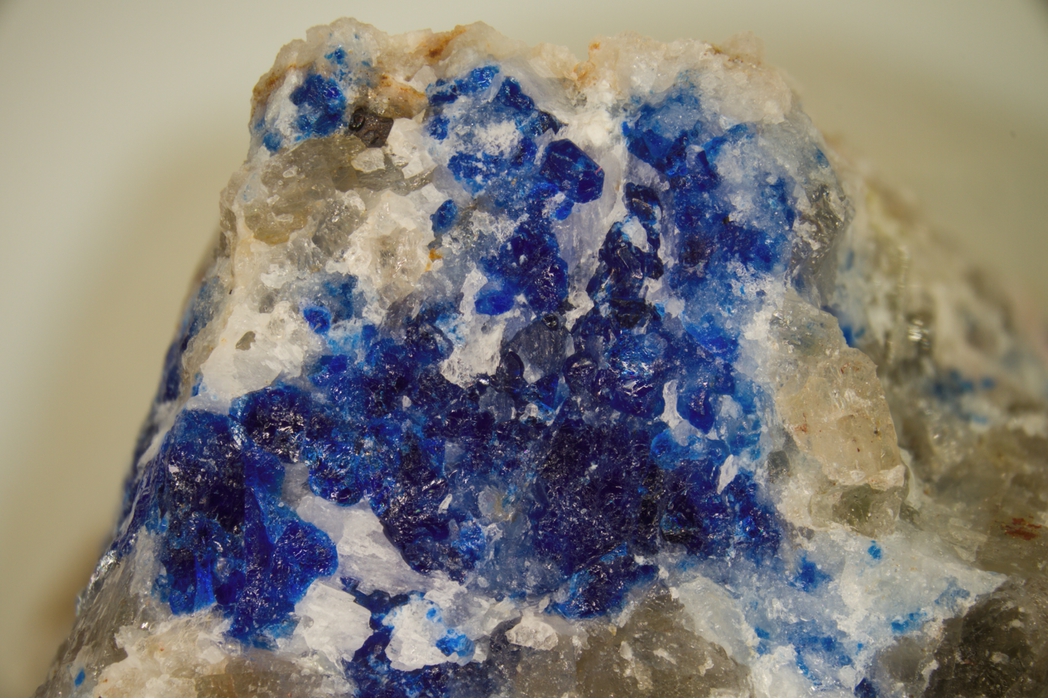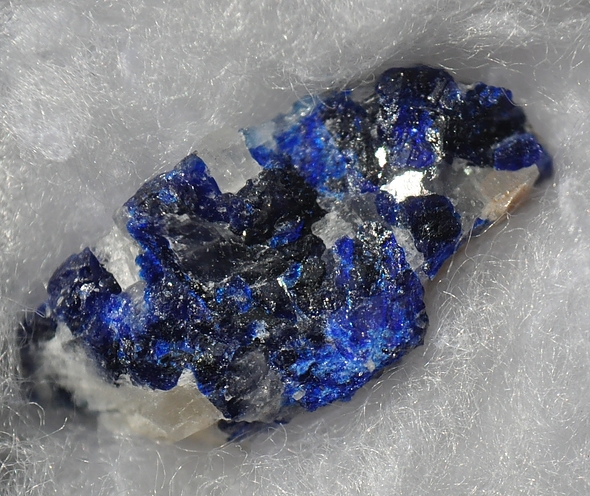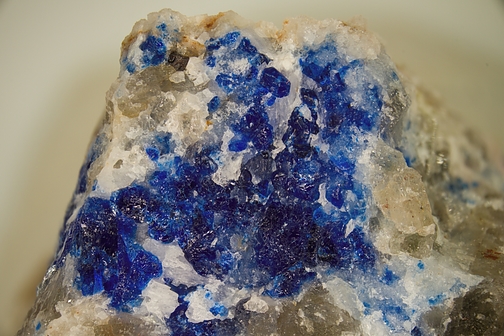Vladimirivanovite
A valid IMA mineral species
This page is currently not sponsored. Click here to sponsor this page.
About Vladimirivanovite
Formula:
Na6Ca2(Al6Si6O24)(SO4,S3,S2,Cl)2 · H2O
Colour:
Dark blue to ink-blue, light blue or greenish-blue to white
Lustre:
Greasy
Hardness:
5 - 5½
Specific Gravity:
2.48
Crystal System:
Orthorhombic
Member of:
Name:
Named in honor of Vladimir Georgievich Ivanov (Владимир Георгиевич Иванов) (1947-2002), Russian mineralogist and geochemist. He studied the lazurite deposits of the Pamirs and Pribaikalye and made significant contributions to the knowledge of the complex processes of lapis formation.
First recognized as “triclinic lazurite” (compare UM1976-26-SiOSO:AlCaClHNa) and later as “orthorhombic lazurite”; but later as an orthorhombic polytype of lazurite with a modulated structure, i.e. Lazurite-O. The modulations arise from a rotation of the sulfate tetrahedra in the sodalite cages.
Lazurite is itself probably just a sulphide-rich variety of Hauyne, or a hypothetical endmember, and the analysis of Vladimirivanovite (Handbook of Mineralogy) indicates that it is sulphate rich and thus closer to hauyne than lazurite.
Lazurite is itself probably just a sulphide-rich variety of Hauyne, or a hypothetical endmember, and the analysis of Vladimirivanovite (Handbook of Mineralogy) indicates that it is sulphate rich and thus closer to hauyne than lazurite.
Unique Identifiers
Mindat ID:
41155
Long-form identifier:
mindat:1:1:41155:8
GUID
(UUID V4):
(UUID V4):
719866d8-0a05-42f0-9998-18a411b78e6b
IMA Classification of Vladimirivanovite
Approved
IMA Formula:
Na6Ca2[Al6Si6O24](SO4,S3,S2,Cl)2 · H2O
Approval year:
2011
First published:
2011
Type description reference:
Classification of Vladimirivanovite
9.FB.10
9 : SILICATES (Germanates)
F : Tektosilicates without zeolitic H2O
B : Tektosilicates with additional anions
9 : SILICATES (Germanates)
F : Tektosilicates without zeolitic H2O
B : Tektosilicates with additional anions
Mineral Symbols
As of 2021 there are now IMA–CNMNC approved mineral symbols (abbreviations) for each mineral species, useful for tables and diagrams.
| Symbol | Source | Reference |
|---|---|---|
| Vla | IMA–CNMNC | Warr, L.N. (2021). IMA–CNMNC approved mineral symbols. Mineralogical Magazine, 85(3), 291-320. doi:10.1180/mgm.2021.43 |
Physical Properties of Vladimirivanovite
Greasy
Transparency:
Translucent
Colour:
Dark blue to ink-blue, light blue or greenish-blue to white
Comment:
Similar colours to hauyne.
Streak:
Blue to white
Hardness:
5 - 5½ on Mohs scale
Hardness:
VHN50=575 kg/mm2 - Vickers
Hardness Data:
Measured
Tenacity:
Brittle
Fracture:
Step-Like
Density:
2.48(3) g/cm3 (Measured) 2.436 g/cm3 (Calculated)
Optical Data of Vladimirivanovite
Type:
Biaxial (-)
RI values:
nα = 1.502 - 1.507 nβ = 1.509 - 1.514 nγ = 1.512 - 1.517
2V:
Measured: 63° (1), Calculated: 66°
Max Birefringence:
δ = 0.010

Image shows birefringence interference colour range (at 30µm thickness)
and does not take into account mineral colouration.
and does not take into account mineral colouration.
Surface Relief:
Low
Dispersion:
Weak.
Pleochroism:
Visible
Comments:
Pleochroism: Light to dark blue; absorption: Z = Y > X
Chemistry of Vladimirivanovite
Mindat Formula:
Na6Ca2(Al6Si6O24)(SO4,S3,S2,Cl)2 · H2O
Crystallography of Vladimirivanovite
Crystal System:
Orthorhombic
Class (H-M):
mmm (2/m 2/m 2/m) - Dipyramidal
Cell Parameters:
a = 9.066(3) Å, b = 12.851(3) Å, c = 38.558(10) Å
Ratio:
a:b:c = 0.705 : 1 : 3
Unit Cell V:
4,492.28 ų (Calculated from Unit Cell)
Comment:
Space group Pnaa (non-standard setting).
X-Ray Powder Diffraction
Powder Diffraction Data:
| d-spacing | Intensity |
|---|---|
| 6.61 Å | (5) |
| 6.43 Å | (11) |
| 3.710 Å | (100) |
| 2.623 Å | (30) |
| 2.273 Å | (6) |
| 2.141 Å | (14) |
| 1.783 Å | (9) |
| 1.606 Å | (6) |
Comments:
Tultui lazurite deposit, Lake Baikal area, Russia. The data are from the type description.
Geological Environment
Paragenetic Mode(s):
| Paragenetic Mode | Earliest Age (Ga) |
|---|---|
| Stage 4b: Highly evolved igneous rocks | >3.0 |
| 35 : Ultra-alkali and agpaitic igneous rocks |
Type Occurrence of Vladimirivanovite
Co-Type Localities:
General Appearance of Type Material:
Rims on lazurite, 0.01-3 mm thick, and elongated grains from 0.2-4 mm in size, and occasionally up to 15 x 20 mm. Rarely as veinlets up to 5 mm.
Place of Conservation of Type Material:
Mineralogical Museum of Saint Petersburg State University, Saint Petersburg (Russia), catalogue no. 1/19366.
Geological Setting of Type Material:
Calciphyres and marble.
Associated Minerals at Type Locality:
Reference:
Sapozhnikov, A.N., Kaneva, E.V., Cherepanov, D.I., Suvorova, L.F., Levitsky, V.I., Ivanova, L.A., Reznitsky, L.Z. (2011) Vladimirivanovite, Na6Ca2[Al6Si6O24](SO4,S3,S2,Cl)2·H2O - a new mineral of the sodalite group. Zapiski Rossiiskogo Mineralogicheskogo Obshchetstva: 140: 36-45.
Synonyms of Vladimirivanovite
Relationship of Vladimirivanovite to other Species
Member of:
Other Members of this group:
| Bolotinaite | (Na7◻)(Al6Si6O24)F · 4H2O | Iso. 4 3m : I4 3m |
| Haüyne | Na3Ca(Si3Al3)O12(SO4) | Iso. 4 3m : P4 3n |
| Lazurite | Na7Ca(Al6Si6O24)(SO4)(S3) · H2O | Iso. 4 3m : P4 3n |
| Nosean | Na8(Al6Si6O24)(SO4) · H2O | Iso. 4 3m : P4 3n |
| Sapozhnikovite | Na8(Al6Si6O24)(HS)2 | Iso. 4 3m : P4 3n |
| Sodalite | Na4(Si3Al3)O12Cl | Iso. 4 3m : P4 3n |
| Tsaregorodtsevite | (N(CH3)4)(AlSi5O12) | Orth. 2 2 2 : I2 2 2 |
Related Minerals - Strunz-mindat Grouping
| 9.FB. | Steudelite | Na3(K17Ca7)Ca4(Al24Si24O96)(SO3)6F6 · 4H2O |
| 9.FB. | Sapozhnikovite | Na8(Al6Si6O24)(HS)2 |
| 9.FB. | Betzite | Na6Ca2(Al6Si6O24)Cl4 |
| 9.FB. | Slyudyankaite | Na28Ca4(Si24Al24O96)(SO4)6(S6)1/3(CO2) · 2H2O |
| 9.FB. | Bolotinaite | (Na7◻)(Al6Si6O24)F · 4H2O |
| 9.FB. | Wenlanzhangite-(Y) | Y2V3+2V4+2(SiO4)2O4(OH)4 |
| 9.FB.05 | Afghanite | (Na,K)22Ca10(Si24Al24O96)(SO4)6Cl6 |
| 9.FB.05 | Bystrite | (Na,K)7Ca(Al6Si6O24)(S5)Cl |
| 9.FB.05 | Cancrinite | (Na,Ca,◻)8(Al6Si6O24)(CO3,SO4)2 · 2H2O |
| 9.FB.05 | Cancrisilite | Na7(Al5Si7O24)(CO3) · 3H2O |
| 9.FB.05 | Davyne | (Na,K)6Ca2(Al6Si6O24)(Cl2,SO4)2 |
| 9.FB.05 | Franzinite | (Na,K)6Ca2(Al6Si6O24)(SO4)2 · 0.5H2O |
| 9.FB.05 | Giuseppettite | (Na,K,Ca)7-8(Al6Si6O24)(SO4,Cl)1-2 |
| 9.FB.05 | Hydroxycancrinite | Na8(Al6Si6O24)(OH)2 · 2H2O |
| 9.FB.05 | Liottite | (Na,K)16Ca8(Al6Si6O24)3(SO4)5Cl4 |
| 9.FB.05 | Microsommite | Na4K2Ca2(Al6Si6O24)(SO4)Cl2 |
| 9.FB.05 | Pitiglianoite | Na6K2(Al6Si6O24)(SO4) · 2H2O |
| 9.FB.05 | Quadridavyne | (Na,K)6Ca2(Al6Si6O24)Cl4 |
| 9.FB.05 | Sacrofanite | (Na61K19Ca32)(Si84Al84O336)(SO4)26Cl2F6 · 2H2O |
| 9.FB.05 | Tounkite | (Na,Ca,K)8(Al6Si6O24)(SO4)2Cl · H2O |
| 9.FB.05 | Vishnevite | (Na,K)8(Al6Si6O24)(SO4,CO3) · 2H2O |
| 9.FB.05 | Marinellite | (Na,K)42Ca6(Al6Si6O24)6(SO4)8Cl2 · 3H2O |
| 9.FB.05 | Farneseite | (Na,Ca,K)56(Al6Si6O24)7(SO4)12 · 6H2O |
| 9.FB.05 | Alloriite | (Na,Ca,K)26Ca4(Al6Si6O24)4(SO4)6Cl6 |
| 9.FB.05 | Biachellaite | (Na,Ca,K)8(Al6Si6O24)(SO4)2(OH)0.5 · H2O |
| 9.FB.05 | Fantappièite | [Na82.5Ca33K16.5](Si99Al99O396)(SO4)33 · 4H2O |
| 9.FB.05 | Kyanoxalite | Na7(Al6-xSi6+xO24)(C2O4)0.5+x · 5H2O (0 < x < 0.5) |
| 9.FB.05 | Balliranoite | (Na,K)6Ca2(Si6Al6O24)Cl2(CO3) |
| 9.FB.05 | Carbobystrite | Na8(Al6Si6O24)(CO3) · 3.5H2O |
| 9.FB.05 | Depmeierite | Na8(Al6Si6O24)(PO4,CO3)1-x · 3H2O (x |
| 9.FB.05 | Kircherite | Na5Ca2K(Al6Si6O24)(SO4)2 · 0.33H2O |
| 9.FB.05 | Sulfhydrylbystrite | Na5K2Ca[Al6Si6O24](S5)2(SH) |
| 9.FB.10 | Bicchulite | Ca2(Al2SiO6)(OH)2 |
| 9.FB.10 | Danalite | Be3Fe2+4(SiO4)3S |
| 9.FB.10 | Genthelvite | Be3Zn4(SiO4)3S |
| 9.FB.10 va | Hackmanite | Na8Al6Si6O24(Cl2,S) |
| 9.FB.10 | Haüyne | Na3Ca(Si3Al3)O12(SO4) |
| 9.FB.10 | Helvine | Be3Mn2+4(SiO4)3S |
| 9.FB.10 | Kamaishilite | Ca2(Al2SiO6)(OH)2 |
| 9.FB.10 | Lazurite | Na7Ca(Al6Si6O24)(SO4)(S3) · H2O |
| 9.FB.10 | Nosean | Na8(Al6Si6O24)(SO4) · H2O |
| 9.FB.10 | Sodalite | Na4(Si3Al3)O12Cl |
| 9.FB.10 | Tsaregorodtsevite | (N(CH3)4)(AlSi5O12) |
| 9.FB.10 | Tugtupite | Na4BeAlSi4O12Cl |
| 9.FB.15 | Marialite | Na4Al3Si9O24Cl |
| 9.FB.15 | Meionite | Ca4Al6Si6O24CO3 |
| 9.FB.15 | Silvialite | (Ca,Na)4(Al6Si6O24)(SO4,CO3) |
Fluorescence of Vladimirivanovite
Not fluorescent.
Other Information
Notes:
Dissolves in HCl and HNO3 with the release of H2S.
Health Risks:
No information on health risks for this material has been entered into the database. You should always treat mineral specimens with care.
Internet Links for Vladimirivanovite
mindat.org URL:
https://www.mindat.org/min-41155.html
Please feel free to link to this page.
Please feel free to link to this page.
Search Engines:
External Links:
Mineral Dealers:
References for Vladimirivanovite
Reference List:
Williams, P. A., Hatert, F., Pasero, M., Mills, S. J. (2011) IMA Commission on New Minerals, Nomenclature and Classification (CNMNC) Newsletter 8. Mineralogical Magazine, 75 (2) 289-294 doi:10.1180/minmag.2011.075.2.289
Localities for Vladimirivanovite
Locality List
 - This locality has map coordinates listed.
- This locality has map coordinates listed.
 - This locality has estimated coordinates.
ⓘ - Click for references and further information on this occurrence.
? - Indicates mineral may be doubtful at this locality.
- This locality has estimated coordinates.
ⓘ - Click for references and further information on this occurrence.
? - Indicates mineral may be doubtful at this locality.
 - Good crystals or important locality for species.
- Good crystals or important locality for species.
 - World class for species or very significant.
(TL) - Type Locality for a valid mineral species.
(FRL) - First Recorded Locality for everything else (eg varieties).
- World class for species or very significant.
(TL) - Type Locality for a valid mineral species.
(FRL) - First Recorded Locality for everything else (eg varieties).
All localities listed without proper references should be considered as questionable.
Russia (TL) | |
| Williams et al. (2011) +2 other references |
Tajikistan (TL) | |
| Williams et al. (2011) +1 other reference |
Quick NavTopAbout VladimirivanoviteUnique IdentifiersIMA Classification Classification Mineral SymbolsPhysical Properties Optical Data Chemistry Crystallography X-Ray Powder DiffractionGeological EnvironmentType Occurrence SynonymsRelationshipsStrunz-MindatFluorescence Other InformationInternet Links References Localities Locality List







 symbol to view information about a locality.
The
symbol to view information about a locality.
The 



Tultui lazurite deposit, Malaya Bystraya River Valley, Slyudyanka, Lake Baikal area, Irkutsk Oblast, Russia